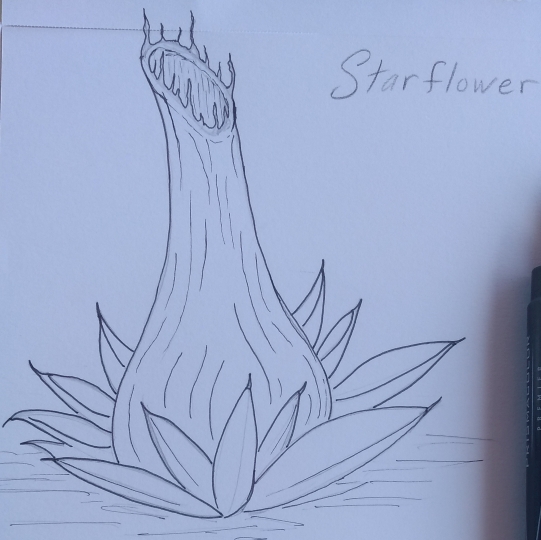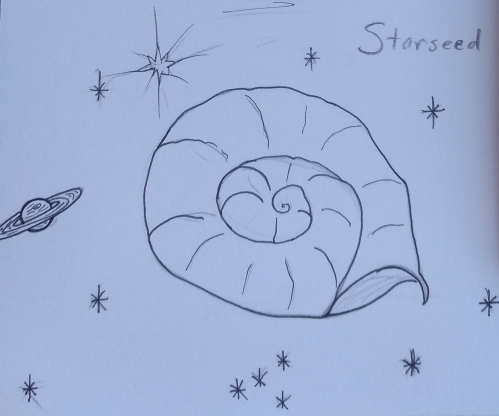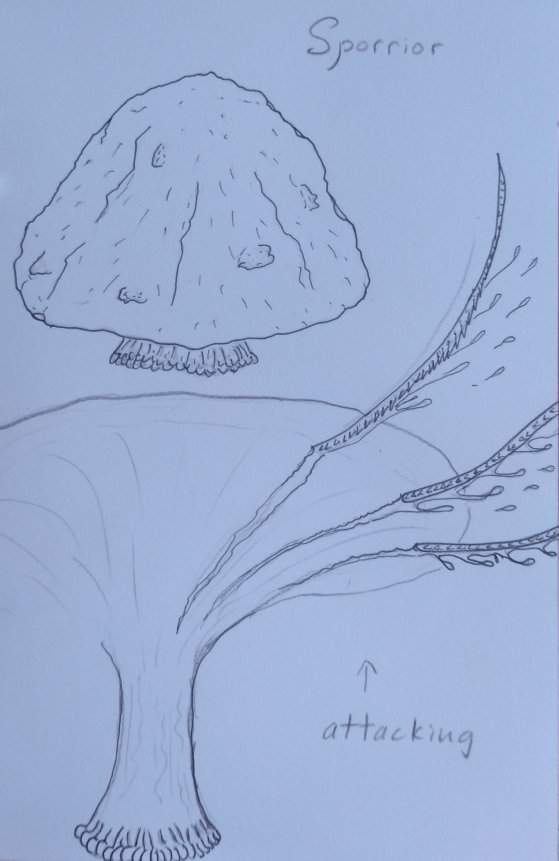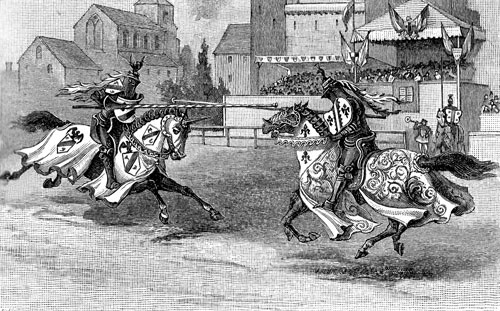Starseeds and Sporriors
These spacefaring fungal creatures have a complex polymorphic lifecycle. Although mindless, they are a dangerous invasive species.
In all of their stages they grow by externally digesting organic or chemically useful compounds and minerals, and also through a photosysthisys-like process that allows them to slowly grow even in the wan starlight of deep space. This process and the mineral-like composition of their outer skins even allows them to grow from the energy of pulsars, gamma streams, and radioactive materials like uranium oxide deposits or atomic warheads.
Their cyclical lifecycle proceeds as follows: from tiny Spores grow Starflowers, which will grow as slow or as fast as local conditions allow. Their color varies depending on the local available nutrients, minerals, and radiation. Their bulb-based, tubular flowers grow until they are large enough to form a Starseed for the journey into space.

At that point the Starflower explosively launches the Starseed into the night sky, using the delicate fronds at the top to sense nearby stellar bodies for its progeny. The Starflower is blown into pieces by this process, which begins a cycle of regrowth. In being destroyed, the Starflower releases its internal defenders and the re-seeders of the flower: the Sporriors. Waiting encased in the Starflowers flesh are the nascent, ambulatory guardians who spread the Spores wherever they go. The destroyed Starflower’s remains become fertile ground for a new, wider batch of Starflowers, and the process continues.
Starflowers sometimes explode when cut or struck, depending on their state of growth.
If the Starseed escapes the local gravitational body, and makes it into space, and it doesn’t end up in a sun, it will break open upon impact, releasing Sporriors from their layered interiors and providing organic material for their new Spores to grow upon. If the Starseed doesn’t make it to space, when it falls back down it breaks open and seeds a new area.

In the asteroid fields and on the tiny iceballs in the depths of dim interstellar space the Starflowers grow slowly and are only large enough to launch little starseeds away from their host body. They release tiny little Sporriors to slowly crawl around spreading new Starflowers.
On planets like Earth with rich local organic deposits, a warm nearby star, and 1G local gravity, the Starflowers will quickly grow to be 90 meters tall or taller before exploding, which launches Starseeds measuring 10-15 meters in diameter. At that size the conical, ambulatory Sporriors released when damaged are 2-3 meters (6-9 feet) tall and in circumference at the bottom of their caps.
Slow but steady walkers, Sporriors spill out from damaged Starflowers and Starseeds, and mill about spreading Spores. They can also climb quite well owing to the hundreds of tiny appendages on the bottom of their trunks. They move very quietly, which combined with their rocky-looking exteriors makes them stealthy.
As they move the Sporriors slowly drip spores suspended in digestive acids, which will grow into Starflowers.
Though lacking a central nervous system or language, they will quietly and steadily walk towards any sound or vibration they sense. And if their tough outer cap touches anything that is moving for more than a moment, be it a sapling or a curious child, they attack.
A hydraulic and chemical reaction causes their conical caps to flip up, inverting. This causes the burning sporewhips, which line the interior of the cap, to fling out in all directions around the Sporrior to a distance of 2-3 meters. The burning sporewhips lie in channels of digestive juices and Spores, and are raspy, so they cut, chemically burn, and possibly infect anything they hit. This reflexive attack also momentarily exposes the Sporriros softer inner cap and stalk.
Sporrior
large fungal plant
Armor Class: 16 (or 9 when attacking)
Hit Points: 48 (4d8+16)
Skills: Stealth +4
Move: 10′, climb 5′
Attack: +4 attack against all creatures within 10 feet / 3 meters, damage 1d4 + 2 slashing, 1d3 acid, and DC 12 Constitution Saving Throw or become infected with burning, itching, tiny-Sporeflower-growing spores. Unless treated with healing magic, technology, or DC 12 Medicine skill checks, the digesting spores will eat away at the infected creature’s body, spreading and dealing 1d12 Hit Points of damage per day.
Challenge Rating: 1

Posted in 3rd edition Dungeons & Dragons / d20 fantasy / Pathfinder, 5th edition Dungeons & Dragons, Creature, d20 Future, D20 Modern, Gamma World, Post-Apocalyptic, Science-Fiction and tagged alien, fungus by Adam A. Thompson with no comments yet.
The zone ghouls cry out, “Glob bloessss the wastelands!”
#NSFW #puppets #apocalypse #robot #mutant
Posted in d20 Future, Fiction, Gamma World, Post-Apocalyptic and tagged #NSFW #puppets #apocalypse #robot #mutant by Adam A. Thompson with no comments yet.
5th edition Dungeons & Dragons Combat Critical Fumble Rules
I like critical fumbles in my D&D game. They increase randomness, speed up combat, and create tension and chaos on the battlefield. For me it’s a significant part of the fun of the game, so I use a critical fumble rule for combat when I’m the Dungeon Master or Referee.
So here’s my house rule: when someone rolls a 1 on an attack roll, they have to roll a d20 again to see how bad the fumble is:
20 – Recovery – the fumble has no major ill effect (feel free to make up some comical reason why)
16-19 – Over-swing – disadvantage on fumbler’s next attack roll
12-15 – Miss-step – advantage on the next attack against fumbler
9-12 – Fall Down – fumbler falls prone
5-8 – Drop Weapon – fumbler drops weapon, or else is dazed next round
4-2 – Wild Swing – attack self or ally (attacking player makes new attack roll)
1 – The Gods Frown – attack self or ally with advantage (attacking player makes new attack rolls), or something equally disastrous
The basic idea is, if you roll a 1, something bad happens. Not only have you failed, but your situation has gotten worse somehow.

I used to use a different simple critical fumble table, where the results were basically a d4, and the lower you rolled the worse it was. I like it because it’s easy to memorize and use without having to refer to a table.
The above table is expanded to use the full numerical granularity of a d20. It also uses the “rolling 20 is good, rolling 1 is bad” game design element.
D4 Fumble Table
4 – off balance – enemies have advantage to attack you next round
3 – fall down – fall prone
2 – drop weapon – drop weapon or are dazed next round
1 – bad swing – attack self or ally
There have been a lot of critical fumble rules published, but recently I’ve seen a fun idea about how to handle fumbles. On the Moisture Farmer’s podcast, I heard them using a new-to-me critical fumble rule. Not only is it great for it’s simplicity, but also for the opportunity to be creative.
If a player rolls a 1, the GameMaster decides what happens to the player’s character. When a GameMaster rolls a 1, the players decide what happens to the GameMaster’s character. So when the GM fumbles, the players get to narrate what happens. When a player fumbles, the GM gets to narrate it.
No boundaries are needed, but as a DM, I’d probably usually limit to to, at worst, damaging your own character or an ally. If the players always end up demanding the the monsters fall on their swords and die, then it would be reasonable for the DM to decide the same thing happened to the PCs. So there’s an opportunity to do some creative role-playing and cooperate to keep things “in bounds”.
Do you use critical fumbles in your game? Why or why not? Let us know in the comments below.
Posted in 5th edition Dungeons & Dragons, d20 Future, D20 Modern, Gamma World, Uncategorized, Variant Rules and tagged critical fumble by Adam A. Thompson with no comments yet.
Gamma World
Frank organized a Gamma World adventure this weekend, and we had a blast. We got to choose whether we were city dwellers with greater Alpha Tech hell-bent on ensuring order or whether we’d rely on more mutations as members of an outcast tribe on the edge of the world with the goal of reclaiming our mother elder from a band of kidnappers. We chose the latter, falling back on the classic underdog hero’s role. This seems fitting for an introduction to a new system…
I ended up a radioactive swarm comprised of rodents that once were lab rats. The shared sentience assumed the name of “Doctor Radkowski”, one of the doctors killed in the blast from the Great Mistake. Over the course of the session, they devoiced the “d” in “rad” to a “t”, as only a punning rat swarm could do. They sang arias, tossed grenades, and swarmed over all the guard bots and mutated plant beasts that they could. Other characters in the party included a radioactive punk rock timecop, an electrified giant spotter with a dual nature and delusions of grandeur, and a shadowy, largely amorphous being that called itself “The Hamburgler”, named for a term it found on a discarded fast food wrapper.
All signs pointed to the kidnappers hailing from the city, including the paths dragged into the sand. The trail grew warmer, and we had to find a pass into the city. We posed as arms dealers and learned of a widow who held a position in town. Soon we were fighting off robotic sentinels and animated plants. In all, we had a blast.
The system is interesting in that it is very similar to 4e DnD, only the character skills are limited, and the bonuses stack on a per-level basis, rather than every-other-level. The generic gamma world is very tongue-in-cheek, necessary for such an otherwise gritty setting. The system leaves a lot to the storyteller to fill in, which leaves lots of room for role playing. Don’t let the tongue-in-cheekness fool you; it’s plenty deadly out there with 20-something hit points and 3d6 and 4d6 damage in the air.
The box set comes with a printed battlemap geared toward the near future setting. Frank used it well, creating some nice verbal terrain out of the cryogenic capsules in the center of the room.
Another thing I liked about the system is that the character sheet isn’t even geared for leveling very far; the post-apocalyptic setting is perfect for one-off and short, multi-session story arcs. This is about the attention span of most of us these days, especially if a gamer has to miss a session every now and again.
Finally, the randomness of the character generation is something to aspire to as a game designer. How does it work that not making choices at the beginning is more fun than choosing my own starting gear? Because it’s challenging. It’s what makes the post-apocalyptic world pop.
Back to another GM thing that Frank did well — the building of Alpha and Omega Tech decks based on which side we chose to play. This made this kind of decision important to the story, a welcome element in any role playing game. Even in a one-off, it’s nice to see the effects of your choices as a player.
In this last image, I was the brown wafer of a disc under the red d6 (I was bloodied at the time). When you play, here are a few final thoughts: don’t forget to use Second Wind once you’re bloodied, always use your Alpha Tech powers (they go away after encounters — trade or gift them if necessary), and don’t get too stuck to the notion of “classes” (ranger, etc.) or “roles” (striker, etc.); if you play it right, everyone has a chance to defend, strike, control, and lead over the course of a single Gamma World session.
Have fun with Gamma World; I highly recommend it from the bottom of my six-valved, mutant heart.
Posted in Gamma World, Review by Adam A. Thompson with no comments yet.


